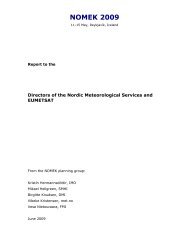International Symposium on Mitigative Measures against Snow ...
International Symposium on Mitigative Measures against Snow ...
International Symposium on Mitigative Measures against Snow ...
Create successful ePaper yourself
Turn your PDF publications into a flip-book with our unique Google optimized e-Paper software.
<str<strong>on</strong>g>Internati<strong>on</strong>al</str<strong>on</strong>g> <str<strong>on</strong>g>Symposium</str<strong>on</strong>g> <strong>on</strong> <strong>Mitigative</strong> <strong>Measures</strong> <strong>against</strong> <strong>Snow</strong> Avalanches<br />
Egilsstaðir, Iceland, March 11–14, 2008<br />
snow avalanche events are reported since 1118 in the country (Björnss<strong>on</strong>, 1980), no village<br />
nor town possesses a reliable record of yearly snow avalanche occurrence before c. 1950-<br />
1970; (ii) the recorded maximum extensi<strong>on</strong> of avalanches was fairly approximate before these<br />
dates; (iii) several locati<strong>on</strong>s where settlements developed were c<strong>on</strong>sidered to be safe before a<br />
dramatic snow avalanche event occurred (Arnalds and others, 2004), and (iv) recent<br />
catastrophic events followed new, unexpected paths or reached a larger runout distance than<br />
previously recognized.<br />
In the present paper, we test the pertinence of the field data, and discuss the validity of the<br />
applicati<strong>on</strong> of the proposed α/β ratio in inhabited areas based <strong>on</strong> known runout distance of<br />
l<strong>on</strong>g reaching snow avalanches.<br />
2. BACK COUNTRY REFERENCE PATHS<br />
In all Icelandic snow avalanche pr<strong>on</strong>e areas, numerous scattered rock debris and boulders are<br />
visible in the lowland, revealing a recurrent activity up to several tens of meters downhill<br />
from the foot of the talus slope (Decaulne and Sæmundss<strong>on</strong>, 2006). Most of the time, such<br />
boulders are the <strong>on</strong>ly lasting indicators for avalanche runout after snow melt. Boulders<br />
transported by snow avalanches represent the minimum farthest downhill runout of the<br />
avalanches, since the snow deposit generally reaches farther downhill than the boulders (Fig.<br />
1). Field observati<strong>on</strong>s of such boulders therefore allow an estimati<strong>on</strong> of the spatial extent of<br />
large snow avalanches.<br />
Figure 1 Scattered snow avalanches transported boulders downhill al<strong>on</strong>g snow avalanche<br />
paths: A − above the village of Hnífsdalur, Northwestern Iceland, B − in the<br />
remote part of the valley Fnjóskadalur, Northern Iceland (photos: Armelle<br />
Decaulne).<br />
It is important to recognize the original boulder deposits as deposited by the snow avalanches<br />
without their subsequent perturbati<strong>on</strong> (i.e. displacement, destructi<strong>on</strong>). A further point which<br />
has to be taken into account is the fact that boulders deposited by different snow avalanches<br />
may have accumulated within the same area. However, it appeared to be possible to<br />
distinguish boulders deposited by different avalanches based <strong>on</strong> the vegetati<strong>on</strong> cover.<br />
Six snow avalanche paths were selected, in four different back country areas (Botn í<br />
Dýrafjörður, Reykjaströnd, Fnjóskadalur and Bleiksmýrardalur (Fig. 2). The six paths were<br />
132 Extreme runout distance of snow-avalanche boulders











